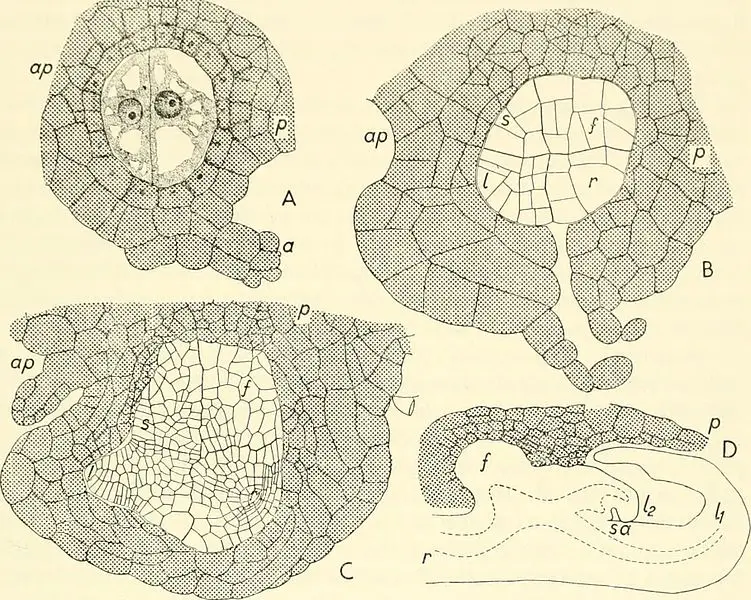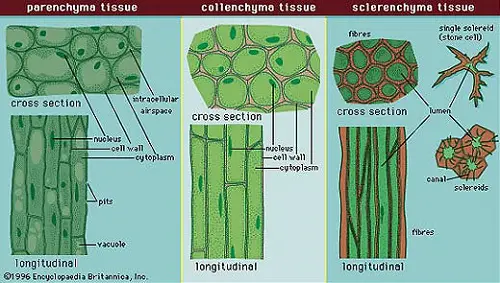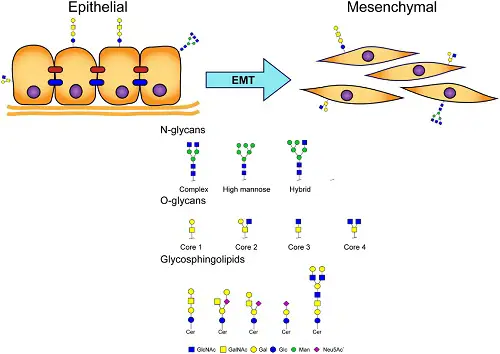
According to their main function, plant tissues are subdivided into:
- meristematic tissues – serve the plants’ growth and
- permanent tissues – perform all other functions.
What is Meristematic Tissue?
After germination, the formation and growth of the plant’s body depend on the activity of the meristematic tissues. Their main function is the cell division (from Greek merismos – “division”). The cells divide, forming new cells that increase their size and differentiate, forming all plant tissues and organs. The meristematic tissues retain their ability to divide, thus leading to the growth and formation of new organs throughout the life of the plants.
The cells of the meristematic tissues are:
- live,
- small,
- isodiametric,
- with no intracellular spaces between the cells,
- with thin cell walls,
- with a relatively large nucleus and
- with dense cytoplasm.
Meristematic tissues consist of initiating cells and their derivatives:
- initiating cells – divide an unlimited number of times, the result of the division is one initiating cell and one derivative meristem cell;
- derivative meristem cells- divide a number of times, then begin to increase their size and differentiate into cells of the permanent tissues.
According to their origin, the meristematic tissues are subdivided into:
- Primary – originated from the germ of the seed,
- Secondary – originate from some of the permanent tissues, which are differentiated and regained the ability to divide.
According to their location, the meristematic tissues are subdivided into:
- Apical meristems – located at the top of the root, stem and branches – determine the growth of roots and stems length;
- Lateral meristems – located laterally in the axial organs of the plant – ensure the root and stem growth;
- Intercalary meristems – inserted into more or less differentiated tissues.
What is Permanent Tissue?
Permanent tissues are composed of cells, which are specialized in the performance of a particular function, but lost their ability to divide. They have determined form and shape. In their early development stages, those cells are similar in structure but they gradually specialize and form permanent tissues.
The cells of the meristematic tissues are:
- living or dead,
- with different size,
- with intercellular spaces ,
- with thin or thick cell walls,
- with a comparatively small nucleus,
- with is relatively little cytoplasm,
- may contain reserve, excretory or secretory substances.
According to their origin, the permanent tissues are subdivided into:
- Primary – originated from primary meristem tissue,
- Secondary – originated from secondary meristem tissue.
Permanent tissues are subdivided into:
- Simple tissues – consist of one type of cells:
- parenchyma – occupies the largest volume of the of plant’s body. The cells are morphologically and physiologically simple, with different degree of differentiation and specialization. It is responsible for photosynthesis, protection, mechanical support, food storage, etc.
- collenchyma – live mechanical tissue, typical for young trees and mature grasses. Collenchyma’s cells are elongated, polygonal with irregular cell wall thickening.
- sclerenchyma – mechanical tissue found in all plants’ organs. It consists of cells with a uniformly thickened and lignified cell wall. Mture cells are dead. Sclerenchyma is a non-uniform tissue in terms of the shape, size and location of the cells in the plants.
- Complex tissues – consist of two or more types of cells:
- phloem – transport tissue consisting of sieve cells, sieve tubes and companion cells. All three cell types are living cells with a strictly defined function and specialization for the transport of assimilates,
- xylem – transport tissue consisting of tracheary elements and fiber cells. It transports water and nutrients from roots to the shoots and leaves.
- epidermis – the outermost single layer of cells covering a plant. The epidermis consists of pavement cells, guard cells and their subsidiary cells, surrounding the stomata and trichomes.
- Special tissues – modified and organized for secretary functions:
- laticiferous tissues – tube-like structures, filled with yellow or white latex.
- glandular tissue – different types of glands, formed by single cell or group of cells.
Similarities Between Meristematic Tissue and Permanent Tissue
Both meristematic tissues and permanent tissues are a set of interconnected cells which:
- have a common origin,
- have specific structure and
- perform a specific function.
Difference Between Meristematic Tissue & Permanent Tissue
Cells
Meristematic Tissue:
All cells in this tissue types are living.
Permanent Tissue:
Cells in this permanent tissues are both dead and living.
Cells shape
Meristematic Tissue:
Cells are small and isodiametric in shape with large lumen.
Permanent Tissue:
Cells are large, with different shapes.
Cytoplasm
Meristematic Tissue:
All cells in this meristematic tissue have a dense cytoplasm.
Permanent Tissue:
The dead cells in the permanent tissue do not have a cytoplasm.
Nucleus
Meristematic Tissue:
All cells in the meristematic tissue have a prominent nucleus.
Permanent Tissue:
The cells in the permanent tissues may have a nucleus or not (the dead cells)
Vacuoles
Meristematic Tissue:
There are no vacuoles in the meristematic cells.
Permanent Tissue:
Cells of the permanent tissues may have vacuoles or not.
Cells Lumen
Meristematic Tissue:
The meristematic cells are with a large lumen.
Permanent Tissue:
In the permanent tissues cells are with a wide or narrow lumen.
Cell Wall
Meristematic Tissue:
The meristematic cells have very thin and cellulosic wall, with no secondary cell wall thickening.
Permanent Tissue:
The cell wall of the permanent tissue can be tin or thick, lignified or cellulosic. Some cells may undergo secondary cell wall thickening.
Pits
Meristematic Tissue:
For the meristematic cells are typical the primary pit fields.
Permanent Tissue:
The pits in the permanent tissue can belong to many different advanced types of pits.
Intercellular Spaces
Meristematic Tissue:
There are no intercellular spaces in the meristematic tissue.
Permanent Tissue:
The permanent tissues can be is loosely packed (parenchyma) or compact (sclerenchyma).
Cell Differentiation
Meristematic Tissue:
The cells of the meristematic tissue are not differentiated.
Permanent Tissue:
The cells of the permanent tissue can be both differentiated and undifferentiated.
Cell Division
Meristematic Tissue:
The undifferentiated cells in the meristematic tissue are capable to rapid division.
Permanent Tissue:
In the permanent tissues, the differentiated cells do not have the ability to divide.
Metabolism of Cells
Meristematic Tissue:
The metabolism in the meristematic tissue is with high rates.
Permanent Tissue:
The metabolism in the permanent tissue is absent or with low rates.
Inclusions and Ergastic Substances
Meristematic Tissue:
No inclusions or ergastic substances are present in these tissues.
Permanent Tissue:
There are inclusions and ergastic substances in these tissues.
Food Reserves
Meristematic Tissue:
This tissue does not store food reserves.
Permanent Tissue:
The cells of some permanent tissues can reserve food (starch).
Location
Meristematic Tissue:
The meristematic tissue is located at determined body parts (root, stems, branches).
Permanent Tissue:
The permanent tissues is present in the entire plant.
Function
Meristematic Tissue:
This tissue is responsible in the growth and formation of new organs throughout the life of the plants.
Permanent Tissue:
The function depends on the tissue type. Permanent tissues provide mechanical support and are involved in conduction, photosynthesis, etc.

Summary:
Plant tissues are subdivided into meristematic and permanent tissue.
Meristematic tissues consist of initiating cells and their derivatives.
The main function of meristematic tissues is the cell division.
Meristematic tissues are subdivided into apical, lateral and intercalary meristem.
Permanent Tissues are composed of cells, which are specialized in the performance of a particular function, but lost their ability to divide.
Permanent tissues are subdivided into simple, complex and special tissue types.
The main difference between meristematic and permanent tissues is in their functions and in the organization of cells.
Author: Dr. Mariam Bozhilova
Dr. Mariam Bozhilova has a Master’s degree in Ecology and PhD in Botany. Her main professional interests are in the fields of ecology, biology and chemistry. She has more than 10 years of professional experience in scientific research and environmental consultancy.












Leave a Reply